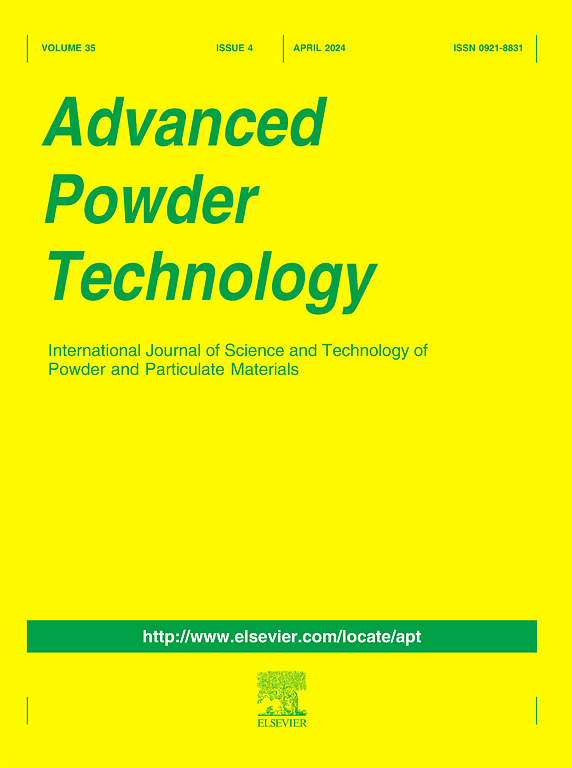Numerical analysis of particle shape influence on erosion and flow behavior in a 90-Degree elbow pipe under Solid-Liquid flow
IF 4.2
2区 工程技术
Q2 ENGINEERING, CHEMICAL
引用次数: 0
Abstract
In this study, an investigation was conducted to examine the influence of particle shape on erosion behavior in curved pipe systems, a critical component in fluid-conveying systems. A combination of numerical and experimental methodologies was utilized, employing the discrete phase model (DPM) and a coupled computational fluid dynamics-discrete element method (CFD-DEM) to simulate particle–fluid interactions within a 90° elbow pipe. The simulations explored how non-spherical particles, shaped with different degrees of corner sharpness, influence erosion rates, particle dynamics, and localized wear patterns. Experimental observations revealed that maximum erosion was concentrated at the outlet region, where the interaction between particle flow dynamics and pipe geometry intensified localized wear. The erosion rates predicted by numerical DPM simulations were overestimated, particularly in the outlet zone, highlighting the model’s limitations in accurately capturing particle interactions. In contrast, a more accurate representation of localized erosion patterns was provided by CFD–DEM simulations, particularly when non-spherical particles were incorporated. It was demonstrated that angular particles with fewer corners caused more concentrated wear due to higher impact forces, whereas particles with more corners distributed forces more evenly, resulting in less severe erosion. Additionally, Higher particle velocities and kinetic energy intensified impact forces, exacerbating wear, while drag and pressure gradient forces shaped particle trajectories, localizing erosion on the elbow’s outer wall. By integrating these findings, the importance of accounting for particle shape and system geometry in erosion prediction models was emphasized. It was established that the CFD–DEM approach, mainly when applied to non-spherical particles, is reliable for predicting wear in complex geometries, providing valuable insights for designing more durable fluid-conveying systems.

固液流动条件下90度弯头管内颗粒形状对冲蚀及流动特性影响的数值分析
在这项研究中,进行了一项调查,以研究颗粒形状对流体输送系统中关键部件弯曲管道系统的侵蚀行为的影响。采用数值与实验相结合的方法,采用离散相模型(DPM)和计算流体动力学-离散元耦合方法(CFD-DEM)模拟了90°弯头管内颗粒-流体相互作用。模拟研究了不同棱角锐度的非球形颗粒如何影响侵蚀速率、颗粒动力学和局部磨损模式。实验结果表明,最大的侵蚀集中在出口区域,颗粒流动力学和管道几何形状的相互作用加剧了局部磨损。数值DPM模拟预测的侵蚀速率被高估了,特别是在出口区域,这突出了模型在准确捕捉颗粒相互作用方面的局限性。相比之下,CFD-DEM模拟提供了更准确的局部侵蚀模式,特别是当非球形颗粒被纳入时。结果表明,棱角较少的颗粒由于冲击力较大,磨损更集中,而棱角较多的颗粒由于冲击力分布更均匀,磨损程度较轻。此外,更高的颗粒速度和动能加剧了冲击力,加剧了磨损,而阻力和压力梯度力形成了颗粒轨迹,局部侵蚀了弯头的外壁。通过综合这些发现,强调了在侵蚀预测模型中考虑颗粒形状和系统几何形状的重要性。结果表明,CFD-DEM方法(主要应用于非球形颗粒)对于预测复杂几何形状的磨损是可靠的,为设计更耐用的流体输送系统提供了有价值的见解。
本文章由计算机程序翻译,如有差异,请以英文原文为准。
求助全文
约1分钟内获得全文
求助全文
来源期刊

Advanced Powder Technology
工程技术-工程:化工
CiteScore
9.50
自引率
7.70%
发文量
424
审稿时长
55 days
期刊介绍:
The aim of Advanced Powder Technology is to meet the demand for an international journal that integrates all aspects of science and technology research on powder and particulate materials. The journal fulfills this purpose by publishing original research papers, rapid communications, reviews, and translated articles by prominent researchers worldwide.
The editorial work of Advanced Powder Technology, which was founded as the International Journal of the Society of Powder Technology, Japan, is now shared by distinguished board members, who operate in a unique framework designed to respond to the increasing global demand for articles on not only powder and particles, but also on various materials produced from them.
Advanced Powder Technology covers various areas, but a discussion of powder and particles is required in articles. Topics include: Production of powder and particulate materials in gases and liquids(nanoparticles, fine ceramics, pharmaceuticals, novel functional materials, etc.); Aerosol and colloidal processing; Powder and particle characterization; Dynamics and phenomena; Calculation and simulation (CFD, DEM, Monte Carlo method, population balance, etc.); Measurement and control of powder processes; Particle modification; Comminution; Powder handling and operations (storage, transport, granulation, separation, fluidization, etc.)
 求助内容:
求助内容: 应助结果提醒方式:
应助结果提醒方式:


